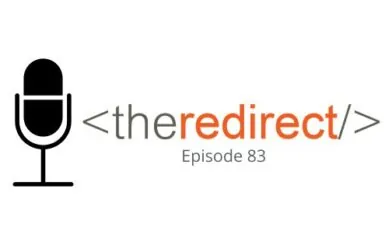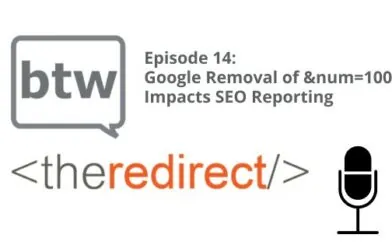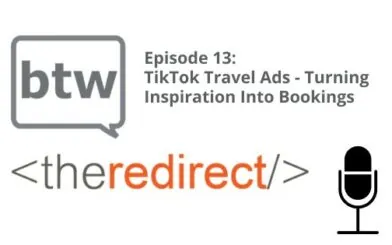Episode 9 / July 21, 2017
Listen now:
In Episode 9 of The Redirect Podcast, we discuss insights from MozCon 2017, the future of a Google redesign and a “feed” format, and tips for optimizing a site in a mobile-first environment. Plus, we leave you with a thought provoking question around the future of search that we will explore in other episodes.
Google Feed
Google’s mobile app has included an “interest and news-based” feed for some time, but soon the feed will become part of the main Google website.
The feed is customizable; users can select and deselect topics in their preferences and also make sure one-off searches, like asking Dr. Google about some symptoms you’re experiencing, won’t influence your feed. (Side note: NPR ran a story this week on the problem of inaccurate featured snippets in Google when people search with health-related queries.) NPR reports that Google is using technology to filter out “potentially upsetting or sensitive content.

As Rand expressed above, many people are concerned that this will only deepen the problem of filter bubbles and echo chambers in what users consume online and how people are influenced to think. Google says that it will also include trending news stories, diverse perspectives, and related articles in the feed. But is there still potential for people to create their own filter bubbles by choosing to follow some sources and not others? The feed will reportedly include a fact check box to combat fake news.
Sources: Google’s New Feed Uses Your Searches for a More Personal Homepage; With Entry Into Interest Curation, Google Goes Head-To-Head With Facebook
Takeaway: Once the Google feed rolls out en masse, it will likely create waves in the SEO world. The future of SEO could be optimizing for the Google news feed. It sounds like Google wants to avoid filter bubbles and fake news in its feed, but time will tell how this plays out on the heels of the 2016 Facebook fiasco.
Mobile and Image SEO
Patrick shared a couple resources from Yoast’s SEO blog, including their Ultimate Guide to Mobile SEO. It’s predicted that sometime in 2018, websites will be crawled and ranked according to their optimization for mobile. (The actual implementation of the mobile-first index is a topic of debate in the SEO world). Script loading speeds and image file sizes are among the factors that determine how well a site performs on mobile.
Takeaway: Optimizing for mobile should be a priority, regardless of when the mobile-first index becomes official. Any barriers to a site’s mobile performance should be addressed now.
Another of Yoast’s blog posts broke down how to optimize images for search engines. For instance, an image’s file name should include keywords describing the image’s contents. A generic “DSC2822.jpg” tells search engines nothing about the photo. Alt text for images should include the targeted keyword for the page it’s on, as well as be relevant to or describe the image. Upload images at the size they should appear on the page, rather than uploading a huge file size and reducing its display size for the page. File sizes can also be reduced by stripping EXIF data before the images are uploaded.
Responsive images are important to how a page loads and displays and can help reduce your site’s bounce rate. A plugin is available to create responsive images in WordPress – make sure this plugin is updated to the latest version. (For WordPress 4.4 and above, photos are responsive by default.) Also, images should be added to the XML sitemap. This helps Google index your images.
After discussing the different facets of image SEO, Patrick posed a question: is image SEO the developer’s job, or the SEOs’ job? While recommending image file names and alt text is straightforward, the traditional SEO may not typically focus on resizing image files, for instance. It seems the roles can get a bit blurred in this area.
Takeaway: Image SEO can be overlooked, but it has an important role in a site’s ranking and performance. SEOs and site developers should discuss who will take on which tasks for optimizing images on a website project.
Click-through Rates for Google Ads
From Search Engine Land: a study has found that overall, click-through rates for the top four Google ad slots have risen 49% since Google eliminated text ads from the right rail of desktop search results pages. Positions 3 and 4 have seen the most increase in click-through rates, while position 5 has suffered slightly.
Takeaway: Thanks, Google?
Takeaways from MozCon 2017
Jason shared his top takeaways from MozCon 2017. In Rand Fishkin’s closing comments, he discussed marketers’ need to invest in content that Google cannot show (or is not showing) in SERPs. Smart search marketers are going to look beyond the algorithm updates for signs and signals that inform how we can optimize for the future.
Also, what if there was a keyword tool that could show how easy it is for Google to answer a search query? If Google continues to progress down the road of filter bubbles and echo chambers, these are all items search marketers should be aware of.
Cindy Krum from MobileMoxie made it clear that mobile-first design and mobile-first indexing are not the same thing, and shared great insights on mobile-first indexing.
Discussions at SearchLove, The Inbounder, and MozCon 2017 have all touched on two main concepts: machine learning and content, both of which allude to mobile-first indexing. Also, if indexing is an easier way to organize data, your site needs to provide a very clear path through your site and to your content.
We also must keep in mind that the voice-first footprint is increasing, as we have a large number of devices that do not have a traditional browser, screen, or even keywords that we interact with.
Listen to the podcast for more of Jason’s takeaways from MozCon, and the burning question he poses regarding the future of search.
Thanks for tuning in! To catch future episodes of The Redirect Podcast, subscribe on Soundcloud, iTunes, or Stitcher.




